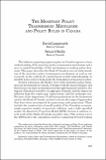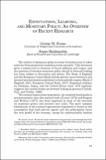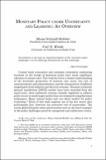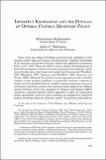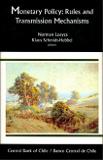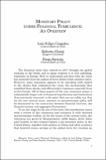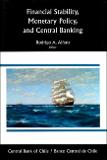Buscar
Mostrando ítems 1-10 de 40
The monetary policy transmission mechanism and policy rules in Canada
The inflation targeting regime in place in Canada requires a clear understanding of the monetary policy transmission mechanism and a way to exploit knowledge of that mechanism in making policy decisions. This paper describes the Bank of Canada's current undestanding of the monetary policy transmission ...
Expectations, learning and monetary policy: an overview of recent research
The conduct of monetary policy in terms of interest rate or other rules has been extensively studied in recent research. This literature gives a central role to forecasts of future inflation and output, and the question of whether monetary policy should be forward- ooking has been subject to discussion ...
Monetary policy under uncertainty and learning: an overview
Central bank economists and academic economists conducting research on the design of monetary policy have made significant advances in recent years. This work has led to a clearer understanding of the desirable properties of interest rate rules, the role of announcements and communication, and the ...
Imperfect knowledge and the pitfalls of optimal control monetary policy
Sixty years ago, Milton Friedman questioned the usefulness of the optimal control approach because of policymakers’ imperfect knowledge of the economy and favored instead a simple rule approach to monetary policy (1947, 1948). These are still live issues, despite the development of powerful techniques ...
New frontiers for menetary policy in Chile
Inflation targeting can be broadly defined as a framework for the conduct of MONETARY POLICY in which the central bank guides its instruments in order to hold inflation near a preannounced target or to bring back to the target. Although understanding the framework is straightfoward, its practical ...
The fiscal footprint of macroprudential policy
Monetary policies leave a fiscal footprint. When the central bank cuts the policy interest rate, this footprint comes through multiple
channels: The demand for currency rises, so the central bank prints more banknotes to accommodate it, and this creates seignorage revenues. Inflation unexpectedly ...
Monetary policy under financial turbulence: an overview
The financial crisis that started in 2007 brought the global economy to the brink and in many respects it is still unfolding especially in Europe. How to understand and deal with the crisis has naturally been the subject of fierce debates that continue today. However some consensus appears to be ...
Monetary policy: rules and transmission mechanisms
Monetary policy must consider the bidirectional relationship between the economy and its central bank. It should therefore address two essential questions: first, how changes in the economy induce a reaction by the central bank, and second, how these policy changes are in turn transmitted to the ...
Monetary policy under financial turbulence
The financial crisis that started in 2007 brought the global economy to the brink, and in many respects it is still unfolding, especially in Europe. While a fierce debate continues on how to understand and deal with the crisis, a consensus is emerging with regard to the originating shocks, the mechanisms ...
Financial stability, monetary policy, and Central Banking
The financial developments of the last decade have had a large impact on the range of risk diversification contracts available to investors. Based on these complex instruments, the investment possibility frontier was shifted outward and increasingly intricate networks were created. At the same time, ...

